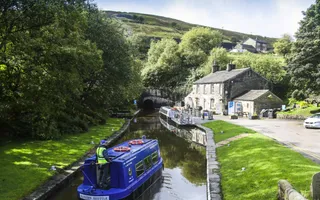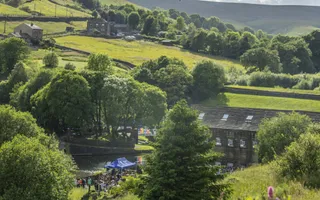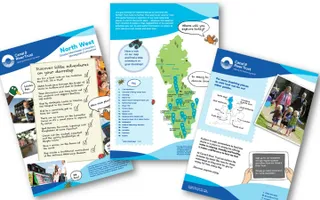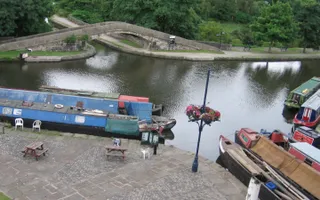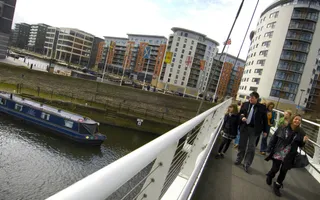The Huddersfield Narrow Canal scales the Pennines and its summit is the highest stretch of canal in Britain.
The superb scenery along the way is full of dramatic contrasts - rugged hills, tranquil wooded countryside, and historic mills and industrial buildings. The canal itself features distinctive very narrow locks.
The Huddersfield Narrow Canal also boasts the impressive Standedge Tunnel the longest, deepest and highest canal tunnel in the country. At three and a quarter miles long, it is not for the faint-hearted and takes around three hours to get through. Walkers can follow the route once taken by boat horses over Marsden Moor Estate, an expanse of wild moorland inhabited by wildlife including golden plover, grouse, curlew and twite.
The canal's rebirth, against all the odds, is the outstanding success of the canal restoration movement. After being derelict for 50 years, it reopened to boats in 2001, thanks to the efforts of the local community and the Huddersfield Canal Society.
There are strict beam constraints on this canal, which has pinch points at a number of sites and is only wide enough for boats up to 6' 10''. If you would like further information about this please contact 03030 404040.
Marsden flight
The Marsden lock flight between L42E and L32E is a challenging section of network and can be prone to water loss from the summit pound of the Huddersfield Narrow Canal. To maintain the water levels as effectively as possible, we have to manage the movements of boats through this section.
For all passages up and down the flight, please contact the Customer Service Team the day before travel, so the locks can be opened the following day. Please be aware that your passage will not be assisted. The lock flight will be opened at 9am and locked up at 3pm on the requested day. All passage must be complete within these times.
If assisted passage is needed, on Tuesdays and Thursdays we have a number of volunteers who may be available to help.
Should you require further information, or to book passage for the Marsden Flight or through Standedge Tunnel, please call our Customer Services team on 0303 040 4040. Alternatively, you can book the flight online.
Passage through Standedge Tunnel
To experience the thrill of taking your boat through Standedge Tunnel you need to book in advance. For more information see our Standedge boating page.
The history
Direct routes from Manchester and the north-west to the waterways of East Yorkshire were proposed in the mid 18th century, but it was not until 1794 that Acts were passed for both the Huddersfield Narrow Canal and the Rochdale Canal as alternative trans-Pennine routes to the Leeds & Liverpool Canal.
Despite a length of less than 20 miles, there were numerous engineering difficulties to overcome on the Huddersfield Narrow. The construction of Standedge Tunnel - the highest, longest and deepest canal tunnel in Britain - almost bankrupted the entire project with around 50 workers being killed during its construction.
The Huddersfield Narrow Canal was built for 70ft-long narrowboats, while the Huddersfield Broad Canal can take wider 57ft x 14ft craft, as used on the Calder & Hebble Navigation. Goods therefore had to be transhipped between the two at Huddersfield. This enforced double handling increased costs to unacceptable levels that were made the more so by the arrival of the Huddersfield & Manchester Railway. The canal was purchased by the railway, soon to become the London & North Western Railway, in 1844, and was used to help construct the new railway tunnel at Standedge. The canal and railway tunnels are connected by short shafts. Decline inevitably followed, and by the early 20th century, there was little traffic.
The impossible restoration - or not
The line was abandoned in 1944 but was retained as a water channel. In 1948, a party of Inland Waterways Association pioneers - among them Tom Rolt and Robert Aickman - took the boat Ailsa Craig from end to end. Their documented journey was to prove the last through the Standedge Tunnel for more than 50 years - but following a major restoration programme, the route is now once again open throughout.
After lying unused for over half a century, the awesome Standedge Tunnel and its bleak surroundings encapsulate within a glance how the Huddersfield Narrow Canal attracted the pessimistic epithet of 'the impossible restoration'.
But the impossible was proved to be possible in 2001. To find out more about taking your boat through Standedge Tunnel see our dedicated Standedge Tunnel pages.


